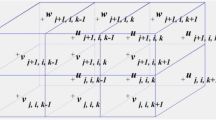Abstract
Two new types of mechanism for the generation of tidal residual flow are revealed with the use of a hydraulic model experiment. A remarkable anticlockwise tidal residual circulation is formed in a model bay due to the presence of a tidal current, the Coriolis force and a horizontal boundary. A similar circulation is also formed due to the presence of a bottom slope, a horizontal boundary and a tidal current which flows normal to the inclination of the bottom slope. The residual circulation in the Sea of Iyo in the Seto Inland Sea is considered to be due to a combination of the effects of the Coriolis force, a bottom slope, a horizontal boundary and the tidal current. We classified some of the generation mechanisms of tidal residual flow which have been described to date into seven types on the basis of vorticity considerations.
Similar content being viewed by others
References
Ianniello, J.P. (1977): Tidally induced residual currents in estuaries of constant breadth and depth. J. Mar. Res.,35, 755–786.
Maddock, L. and R. D. Pingree (1978): Numerical simulation of Portland tidal eddies. Est. Coast. Mar. Sci.,6, 353–363.
Oonishi, Y. (1975): Surface interpolation by a spline method. J. Oceanogr. Soc. Japan,31, 259–264.
Oonishi, Y. (1977): A numerical study on the tidal residual flow. J. Oceanogr. Soc. Japan,33, 207–218.
Oonishi, Y. (1978): A numerical study on the tidal residual flow: vertical motion induced by tidal current. J. Oceanogr. Soc. Japan,34, 140–159.
Robinson, I.S. (1981): Tidal vorticity and residual circulation. Deep-Sea. Res.,28, 195–212.
Tee, K.T. (1976): Tide-induced residual current, a 2-D nonlinear numerical tidal model. J. Mar. Res.,34, 603–628.
Yanagi, T. (1974): Dispersion due to the residual flow in the hydraulic model. Cont. of the Geophysical Institute Kyoto University,14, 1–10.
Yanagi, T. (1976): Fundamental study on the tidal residual circulation I. J. Oceanogr. Soc. Japan,32, 199–208.
Yanagi, T. (1977): Tidal residual flow in Kasado Bay. J. Oceanogr. Soc. Japan,32, 335–339.
Yanagi, T. (1978): Fundamental study on the tidal residual circulation II. J. Oceanogr. Soc. Japan,34, 67–72.
Yanagi, T. (1979): Vertical residual flow in Kasado Bay. J. Oceanogr. Soc. Japan,35, 168–172.
Yasuda, H. (1980): Generating mechanism of the tidal residual current due to the coastal boundary layer. J. Oceanogr. Soc. Japan,35, 241–252.
Zimmerman, J.T.F. (1978): Dispersion by tide induced residual current vortices. In: Hydrodynamics of Estuaries and Fjords, ed. by J. Nihoul, Elsevier, Amsterdam, p. 207–216.
Zimmerman, J.T.F. (1981): Dynamics, diffusion and geomorphological significance of tidal residual eddies. Nature,290, 549–555.
Author information
Authors and Affiliations
Rights and permissions
About this article
Cite this article
Yanagi, T., Yoshikawa, K. Generation mechanisms of tidal residual circulation. Journal of the Oceanographical Society of Japan 39, 156–166 (1983). https://doi.org/10.1007/BF02070259
Received:
Revised:
Accepted:
Issue Date:
DOI: https://doi.org/10.1007/BF02070259




